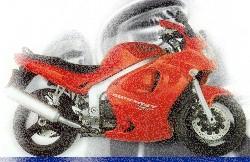

January 2000
Motorcycle Sport and LeisureSUBSCRIPTION RATES EmailMotorcycle Sport and Leisure is a broad based, no nonsense, monthly magazine (published in the United Kingdom) which cuts through the bull so many mags pump out. It offers straight forward reporting, news, information and a sensible biker editorial all of which (somehow) manages to cross the range of motorcycling interests, not only within the UK, but throughout the world. This article reprinted with permission from Motorcycle Sport and Leisure. Copyright 2000. Unauthorized duplication or distribution prohibited without prior permission |
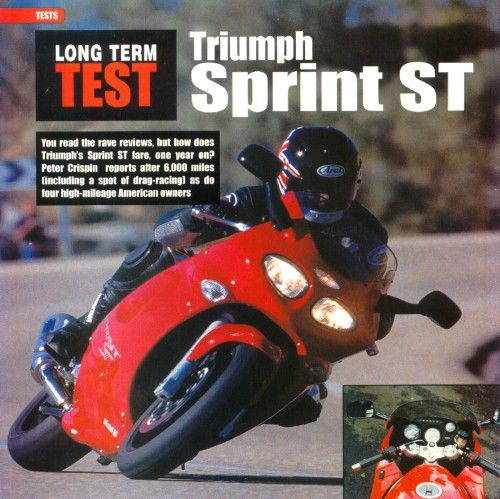
"You read the rave reviews, but how does Triumph's Sprint ST fare, one year on? Peter Crispin reports after 6,000 miles (including a spot of drag-racing) as do four high-mileage American owners."
I picked it up from Greens of Longton on a wet March 1st - £7,250 (a £700 discount on list price) plus £400 for panniers and £366 (10% discount) for tank bag, inner pannier bags, heated grips, mudguard extensions and a top rack. With plenty of mud and salt on Peak District roads the bike was filthy by the time I reached home. Nevertheless, the machine looks likely to survive many winters, as there’s no chrome except for the cable/lever adjusters and steering stem nut - almost every other major external part is either stainless, plastic or alloy. The bike is easy to clean superficially - just wash the deeply-lacquered bodywork. The stainless exhausts and thick engine paint also keep things healthy under the fairing.
There were three small faults on first inspection: The plastic fork protectors faced slightly sideways; the offside flexible mirror shroud was not hooked over its fairing mount, and all three front lights had misted up (there was visible water in the bottom of the central pilot light). The first two took five minutes to fix, whilst the lights subsequently dried out and have shown no sign of damp since, despite riding for hours in much worse weather.
Early modifications included:
1) Moving levers and switches inwards by about a centimetre and shortening the bars, which is a bit fiddly, but looks tidier and gives a worthwhile improvement in wind protection.
2) Drilling the clutch lever near the fulcrum and inserting a small stainless self-tapper provides a simple span adjuster.
3) Gear and brake linkages were adjusted to raise and lower the foot levers respectively. Even in its highest setting, however, it is still easy to wear shoe leather away on fast lefthanders if one rides with the foot under the gear lever.
Heroes Blobbed |
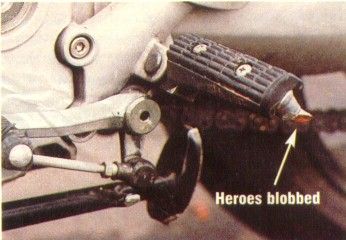 |
Brim-to-brim, the first tanks yielded 56, 50, 56, and 55 mpg, which I find astonishing, not to mention vaguely embarrassing. I have twice got over 60 mpg and the worst ever was low forties. That involved lots of short town trips on a cold engine, plus marshalling a running race, and later consciously staying in 3rd and 4th gears and using high revs on fast A-roads. I can't explain it, and my footrests and tyres are wearing down normally, so I’m not pussyfooting around, but I have to report as I find. The odometer is digital and seems as accurate as any I’ve used. I do use the upper gears a lot, especially as the clutch is superfluous above third, and I don’t even think about filling up until I see 200 on the trip meter. One attempt find the ultimate range saw 250 miles, at which point the 21-litre tank accepted just twenty litres. Fuel injection rules OK! From being reasonably accurate, the fuel gauge started refusing to register much beyond half full. The fuel light also started to come on at 70 miles or less, when previously it had waited until 110-125 miles before telling its unduly pessimistic tales.
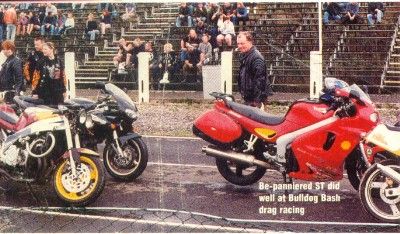 |
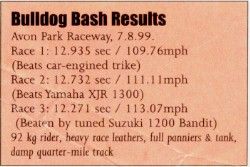 |
| The pannier kit was a revelation, consisting of about a hundred separate parts. No wonder dealers complained it was taking them an uneconomic time to fit them! They now come at least slightly pre-assembled, but it still leaves six pages of instructions - still, it’s nice to do a bit of DIY. Included in the kit is a folding lifting handle which sits just forward of the nearside pannier and makes it even easier than before to lift a fully-laden bike on to its centre stand. The silencer has to be lowered with the panniers, and the front edge of the can has since dug in a couple of times. Having said that, there’s no fully-fledged tourer that comes close to the sports capability of the Sprint, and only Ducati’s ST2/ST4 and the VFR do so amongst the all-rounders. Passengers find the rack an acceptable substitute for the missing grab-rail and some think it an improvement in so far as it offers a range of hand holds. The rack has a laughable litigation-conscious 5kg maximum load warning cast into it - a top case weighs almost that! | 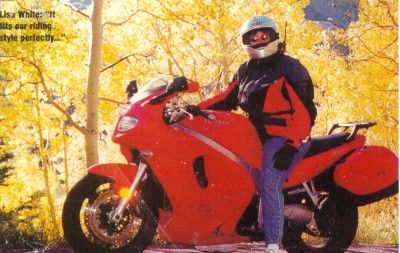 |
By 1,500 miles the gears had become very slick and seem even sweeter at the current 6,000 miles. In a break with tradition, selecting first with a cold engine is noiseless, but with a warm engine there’s a light but audible clunk (thinner oil when hot?). Talking of sound effects, the horn gives the usual anaemic beep at high speed and fitting my old twin air horns and compressor is going to be tight.
Recalls |
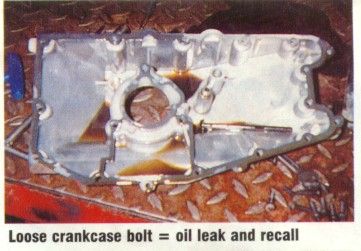 |
For the first time in thirty years of motorcycling I called on a rescue service to get me home. The RAC had instructions to ferry affected bikes to, “a Triumph dealer of the rider’s choosing”. I toyed with the idea of suggesting San Francisco, but settled for Stoke. Greens lent me a courtesy bike and did the work the same afternoon. A new rear tyre was fitted to replace the original which was oil covered on the offside. If it had been at my own cost I’d have persevered with the old tyre and ridden carefully round right handers for the first hundred miles. As it was, with the bike regularly ridden over to the sidewalls, I was glad of the fresh Bridgestone. An additional side benefit of the recall work was a sump-full of new synthetic oil; not to be ignored at twenty-odd quid!
Chain adjustment is a doddle, needing only a single clamp nut loosening before the special C-spanner is gently tapped round to the correct setting and the clamp nut re-tightened. How frequently depends on riding and weather conditions but I do it about every 300-500 miles.
The hazard flashers are only operable when either the ignition or parking lights are on. I’d prefer to use them with the steering lock on but no parking lights (which only flatten the battery quicker and are redundant when four flashers are working). Incidentally, it sounds wimpish, but a gear indicator would be handy on the Sprint. With today’s smooth high revving engines and fifth and sixth being very close ratios (the difference between them is only about 500rpm) it’s difficult to tell from the rev counter/speedo which of the top two gears are in use at legal speeds. In any case, five slightly wider ratio gears would be perfect for this engine. Whilst in niggle mode, the instruments are fine but it would be good to have warning lights which dim at night, like many car displays do once the headlights are on. Fuel and temperature gauges with no units of measurement and a full-scale deflection of only 75 degrees, seem like a bit of a lost opportunity.
There have been only three small faults in service besides the recall. A rear indicator bulb failed at 3,750 miles and the battery flattened enough after three weeks that the engine turned over a little sluggishly and wouldn’t start. I thought I had spare bulbs but Triumph use a new smaller, lighter type. The battery was topped up from a charger and the engine duly started. Three weeks doesn’t seem long, however, for a new bike with only a digital clock draining the battery.
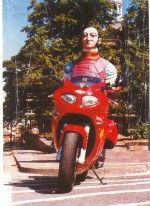 |
The 6,000-mile front tyre is looking dodgy for a slippery winter and the
rear (fitted at 1,200 miles) will be replaced about the same time in another
600-700 miles. Incidentally, a £200 set of tyres every 6,000 miles is the
equivalent to 3.3p/mile or about £1.50 extra per gallon. Gulp! The overall verdict so far? 8 out of 10. The Sprints keeps me ahead of practically every crotch rocket on real-world twisties but is just as good for an all-day distance ride to see a client. Truly a superb all-rounder. I wonder how it goes on track days? Watch this space. PC |
Paul Steinbacher - 17,000 miles Warminster PennsylvaniaWe were considering a few different mounts, but a ride on the Sprint won us over. The riding position was slightly sporting, but with the addition of GenMar risers makes it nearly correct for me. The handling is outstanding for all I ask of the bike - commuting, weekend sport riding and touring, especially since a change to Dunlop 207's which give a much more secure feeling than the OE tyres.. I'm on the third set of tyres, having used a set of Michelin MX90s as the second set. The suspension is a bit softer than I'd like, front and rear, but not a bad compromise I suppose. I've averaged about 48 mpg(US) with the bike since new. Strange as it may seem I get better mileage when riding harder. I just replaced the chain, but think that was due to having it tightened too much at one service and not noticing for about 200 miles. The rear brake pads were replaced at 6,000 miles and both ends will need renewing soon. The cost of servicing seems rather high ($450 US for a 12,000 mile service) driven as much by the $50 Triumph oil as anything else. The heated grips have quit working twice, only to mysteriously start working again after I start probing around under the fairing. The right-hand pannier started to leak slightly at the seam on the inner half of the bag. When I inquired about this, I was told to seal it with black silicone. Despite these niggles, one of the things I really liked about the Sprint was the range of factory accessories. I plan on keeping it for the foreseeable future, as I don't think there's a better do-it-all mount available. |
Martin Retherford - 13,000 miles CaliforniaMy ST currently has 13,769 miles. Likes include the fuel economy (48-54 miles per US gallon) which includes all street, highway and canyon carving. Handling is excellent but the riding position is not nearly as hard on you as your run-of-the-mill performance bike. Its physical size doesn't exceed the size required for splitting lanes, even with the bags installed. I love the torque of the three-cylinder motor, which pulls hard from 3,000 to 7,500rpm. The seat is very comfortable and have gone the full length of a tank of fuel without any desire to stop - that's 220 miles at 50-70mph. Dislikes: Non-adjustable handlebars; lack of a full rear mudguard; lack of completely adjustable suspension; lack of alternatives to the factory accessories and service. Summary: In short it's the best single bike I've ridden so far, the best combination of touring and sport on offer. |
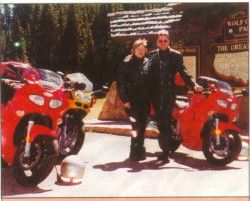 |
Lisa and Richard White - 12,000/9,500 miles Houston, TexasOn March 6th, I bought my red Sprint ST, and in May my husband Richard bought his. We love them both. On two extended trips (1,700 and 4,200 miles) they performed well, with the stock seat causing no major discomfort, and the three-bag luggage means you can take anything. We did become a bit tender once we got over 400 miles a day, but the STs allowed us to be comfortably on the road for two weeks. The torque and acceleration are a blast on twisty roads! As for gas consumption, both bikes generally get 45-50mpg - one tank dropped into the 30's, but several have gotten close to sixty. There have been some problems, though nothing I would consider major. My bike, being an early one, |
| was subject to recalls for the sump bolt and centre stand - it
also experienced fried wiring in the ignition harness, because of bad routing.
All these problems were addressed by Triumph on later bikes, and Richard's ST
had none of them. We did have to replace the batteries on both bikes between
5,500 and 6,000 miles, which was more frustrating than anything else. Also, if
you get aggressive the lower fairing has a tendency to touch the road before
the pegs. Richard's did this when we were riding two-up one day. Overall, we reckon that the Sprint is such a good all-rounder that we have no need to add a sports bike or a tourer to our stable. It fits our riding style perfectly and makes everything else seem too uncomfortable or too stodgy to be fun! - Lisa |
|